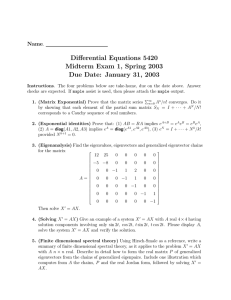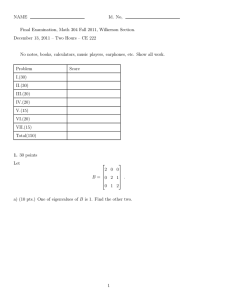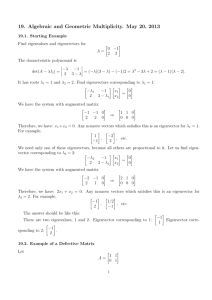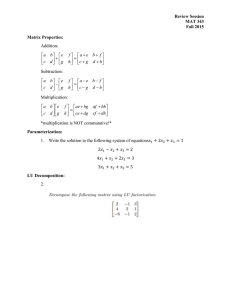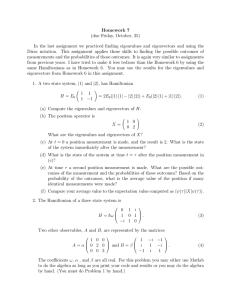M641 Fall 2012 Assignment 2, due Wed. Sept. 12
advertisement
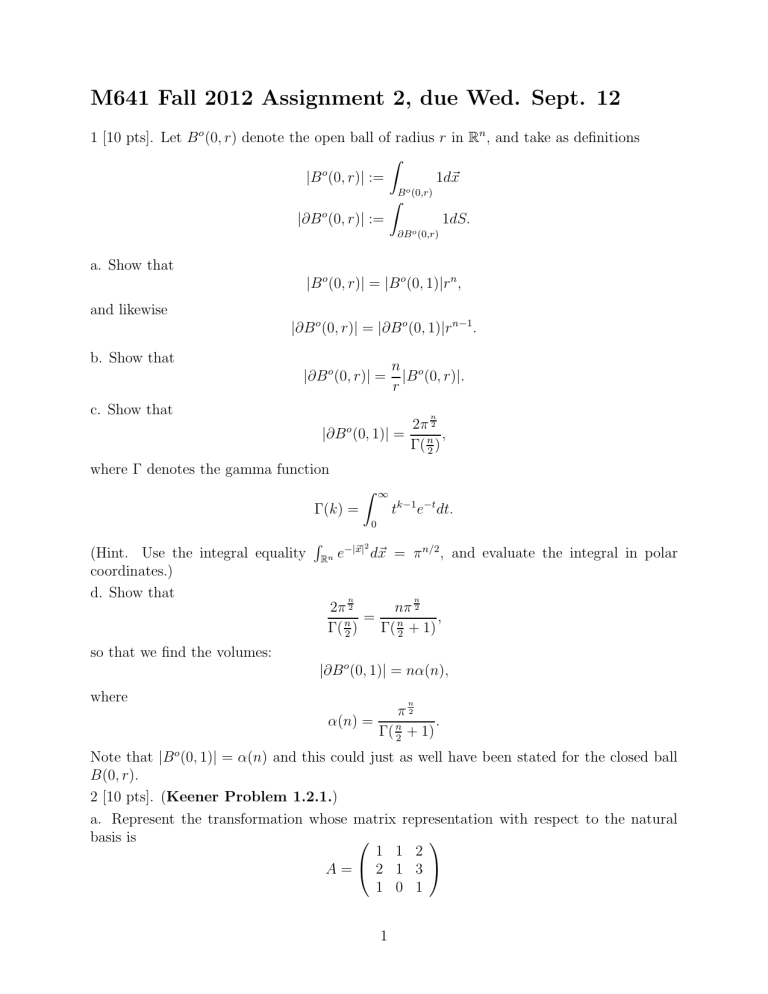
M641 Fall 2012 Assignment 2, due Wed. Sept. 12
1 [10 pts]. Let B o (0, r) denote the open ball of radius r in Rn , and take as definitions
ˆ
o
|B (0, r)| :=
1d~x
B o (0,r)
ˆ
o
|∂B (0, r)| :=
1dS.
∂B o (0,r)
a. Show that
|B o (0, r)| = |B o (0, 1)|r n ,
and likewise
|∂B o (0, r)| = |∂B o (0, 1)|r n−1.
b. Show that
|∂B o (0, r)| =
c. Show that
n o
|B (0, r)|.
r
n
2π 2
|∂B (0, 1)| = n ,
Γ( 2 )
o
where Γ denotes the gamma function
Γ(k) =
(Hint. Use the integral equality
coordinates.)
d. Show that
´
ˆ
∞
tk−1 e−t dt.
0
2
Rn
e−|~x| d~x = π n/2 , and evaluate the integral in polar
n
n
2π 2
nπ 2
,
n =
Γ( 2 )
Γ( n2 + 1)
so that we find the volumes:
|∂B o (0, 1)| = nα(n),
where
n
π2
α(n) = n
.
Γ( 2 + 1)
Note that |B o (0, 1)| = α(n) and this could just as well have been stated for the closed ball
B(0, r).
2 [10 pts]. (Keener Problem 1.2.1.)
a. Represent the transformation whose matrix representation with respect to the natural
basis is
1 1 2
A= 2 1 3
1 0 1
1
relative to the basis {(1, 1, 0)T , (0, 1, 1)T , (1, 0, 1)T }.
b. The representation of a transformation with respect to the basis
{(1, 1, 2)T , (1, 2, 3)T , (3, 4, 1)T }
is
1 1 1
A = 2 1 3 .
1 0 1
Find the representation of this transformation with respect to the basis
{(1, 0, 0)T , (0, 1, −1)T , (0, 1, 1)T }.
3. [10 pts] (Introduction to generalized eigenvectors) Recall that if λ is an eigenvalue
of A ∈ Rn×n , then its algebraic multiplicity is the number of times it repeats as a solution
of the characteristic equation det(A − λI) = 0 and its geometric multiplicity is the number
of linearly independent eigenvectors it has. If the algebraic and geometric multiplicities
associated with each eigenvalue for a matrix are equal, then the eigenvectors for the matrix
form a full basis of Rn and the matrix can be diagonalized by P = ~v1 ~v2 . . . ~vn .
If there are eigenvalues of geometric multiplicity differing from their algebraic multiplicity,
then we need to consider generalized eigenvectors.
Definition. Suppose that for some value λ and some integer p ≥ 1 there exists a vector ~v
so that
(A − λI)p~v = 0 but (A − λI)p−1~v 6= 0.
Then ~v is said to be a generalized eigenvector for λ of index p.
Find the eigenvalues, eigenvectors and generalized eigenvectors for the matrix
3 −1 1
A = 2 0 1 .
1 −1 2
4. [10 pts] (Representation by Direct Sum) For a matrix A ∈ Rn×n , let λ1 , λ2 , . . . , λk
denote the distinct eigenvalues of A with respective algebraic multiplicities n1 , n2 , . . . , nk ,
where k ≤ n and according to the Fundamental Theorem of Algebra
n1 + n2 + · · · + nk = n.
Let Xj denote the subspace spanned by the generalized eigenvectors for λj . (Note that a
regular eigenvector is also a generalized eigenvector, and so should be included in this set.)
Theorem. For any matrix A ∈ Rn×n , and for j ∈ {1, 2, . . . , k}, the subspace Xj is invariant
under A, has dimension nj , and satisfies
(A − λj I)nj ~v = 0 ∀~v ∈ Xj .
Moreover, the space Rn is a direct sum of the spaces X1 , X2 , . . . , Xk .
2
Definition. To say Xj is invariant under A means ~x ∈ Xj ⇒ A~x ∈ Xj .
Definition. When we say that Rn is a direct sum of X1 , X2 , . . . , Xk , we mean that for any
~x ∈ Rn there exists a unique collection ~x1 ∈ X1 , ~x2 ∈ X2 , . . . , ~xk ∈ Xk so that
~x = ~x1 + ~x2 + · · · + ~xk .
For the matrix
3 −1 1
A = 2 0 1 ,
1 −1 2
from the previous problem, with eigenvalues λ1 = 1 and λ2 = 2 and associated eigenspaces
X1 and X2 , find the unique vectors ~x1 ∈ X1 and ~x2 ∈ X2 so that
1
0 = ~x1 + ~x2 .
1
5. [10 pts] (Jordan Canonical Form) Although some matrices cannot be diagonalized,
all matrices can be put into Jordan Canonical form. If a matrix A ∈ Cn×n has k distinct
eigenvalues {λi }ki=1 with respective multiplicies {ni }ki=1 , then the Jordan canonical form of
A is
J1 0 0
J = 0 ... 0 ,
0
0
Jk
where each submatrix Ji has the form
λi 1 0 0
0 λi 1 0
Ji =
0 0 ... 1
0 0 0 λi
.
We construct our matrix P as follows: let its first n1 columns comprise the generalized
eigenvectors associated with λ1 , its next n2 columns the generalized eigenvectors associated
with λ2 etc. Then the Jordan form of A is easily computed as
J = P −1 AP.
Verify that this last expression gives the Jordan form for the matrix A from Problem 2, and
use this to solve the matrix equation
3
2 .
A~x =
3
3




